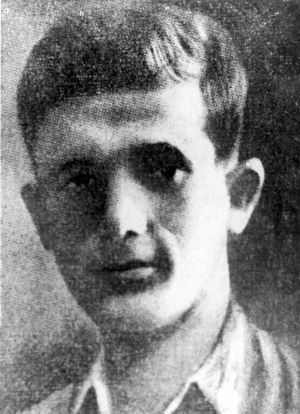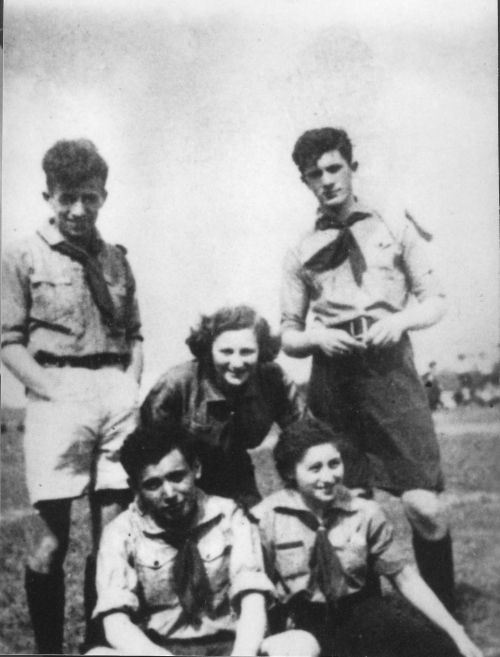Mordechai Anielewicz

Mordechai Anielewicz was born in Wyszkow near Warsaw in 1919, and grew up in a working class Jewish family. After finishing secondary education he joined the Zionist movement Ha-Shomer ha- Tsa’ir where he distinguished himself as an organiser and leader. On the 7 September 1939 a week after the German invasion of Poland Anielewicz went with members of his group from Warsaw to the eastern regions of the country. Anielewicz attempted to cross the Rumanian border in order to open a route for young Jews to go to Palestine. However, he was apprehended and imprisoned in a Soviet prison cell. He was released and returned to Warsaw. He went to Vilna where Jewish refugees and other political groups had gathered, to convince Jews to return to Poland and resist the harsh German rule. He returned to Warsaw in January 1940 with his girlfriend Mira Fuchrer where he continued his work with the Jewish Underground.
By mid-1941, Anielewicz began concentrating on transforming the underground youth movements into an armed resistance movement and he also began creating self-defence organisations within the Warsaw ghetto. Emanuel Ringelblum recalled a Ha-Shomer ha – Za’ir seminar in January 1942: Once, during a break between classes in the Ha-Shomer seminar (I lectured on the history of the Jewish labour movements), Mordechai Anielewicz and Yosef Kaplan called me down into the yard of the building at 23 Nalewki Street. They let me into a special room and showed me two revolvers. These revolvers, the members of the central leadership explained to me, were to be employed to train youth in the use of arms. This was the first step taken by Ha-Shomer Ha-Za’ir even before the Fighting Organisation was founded. Anielewicz was engaged in underground work in the Bedzin- Sosnowiec area in eastern Silesia and he returned to Warsaw when he learnt about the mass deportations from Warsaw which commenced on the 22 July 1942. In the beginning of October1942 discussions were held by the various Jewish underground organisations and on the 15 October the decision was taken to form a joint fighting organisation, and the Bund agreed to join the Z.O.B (Zydowska Organizac Bojowa – Jewish Combat Organisation) without reservation.
The first measures the Z.O.B took was against the leading Jews who had helped the Germans during the mass deportations from Warsaw to the Treblinka death camp, such as the two Jewish Order Police members Jozef Szerynski, who was wounded by an attack by a Z.O.B. member on 20 August 1942 and Jakub Lejkin was murdered on 29 October 1942. Also Yisrael First, the director of the Economic Department of the Judenrat, and a known Gestapo helper was also murdered by the Z.O.B. on 29 November 1942.. When the Germans commenced the Second “Aktion” from the 18 – 22 January 1943 to Treblinka death camp, it was a very different Jewish population that faced them. Von Sammern- Frankenegg the SSPF Warsaw had promised Himmler that the ghetto “excess” would be deported without undue difficulty. Robust bunkers and hideouts had been constructed during the period from the cessation of the “aktion” on the later part of September 1942 to January 1943, the Z.O.B were now preparing to fight the Germans in the ghetto streets, as Von Sammern, was soon to find out.
The first group involved in the January fighting was a band of Ha-Shomer ha- Za’ir members commanded by Mordechai Anielewicz. Armed with pistols and hand grenades, the group attached itself to a long procession of Jews being led to the Umschlagplatz. The fighters dispersed along the length of this march and each of its members singled out one of the soldiers guarding the column. At a given signal, the fighters sprang out of line and opened fire. A short battle, on the corner of Zamenhofa and Niska, followed, with a number of Germans killed and wounded, while others fled. Most of the Jewish fighters fell as well, Eliyahu Rozanski, who had assassinated Lejkin, fought with great valour, died from his wounds. Margalit Landau, who also took part in the demise of Lejkin was killed in this battle. Anielewicz also fought with valour until his ammunition ran out, then snatched a gun out of the hands of a German soldier and was saved by the quick intervention of a fellow underground fighter. On the 19 April 1943 the Germans entered the Warsaw Ghetto to eliminate the ghetto, Chaim Frimmer a fighter in Braudo’s squad recalled: At six a column of infantry entered. One section of the column turned into Wolynska Street and the other remained in place, as if awaiting orders. Before long the Jewish Police came through the gate. They were lined up on both sides of the street and, as ordered, began to advance toward us. I would report everything to a fighter lying down not far from me, who in turn passed word on to the command room, where Mordechai Anielewicz, Yisrael Kanal and others were seated. After the Jewish Police crossed the street an armed mobile German column began to move. I was ordered to wait until the middle of the column had reached the balcony and then throw a grenade at, which would serve as a signal to start the action. A mighty blast within the column was the signal to act. Immediately thereafter grenades were thrown at the Germans from all sides, from all the positions on both sides of the street. Above the tumult of explosions and firing, we could hear the sputter of the German Schmeisser operated by one of our men in the neighbouring squad. I myself remained on the balcony and spewed forth fire from my Mauser, onto the shocked and confused Germans. The battle lasted for about half an hour, the Germans retreated leaving many dead and wounded in the street. Again my eyes were peeled on the street, and then two tanks came in, followed by an infantry column. When the tank came up to our building, some Molotov cocktails and bombs put together from thick lead pipes were thrown at it. The big tank began to burn and engulfed in flames, made its way toward the Umschlagplatz. .The second tank remained in place as fire consumed it from every side.
On the 23 April Mordechai Anielewicz wrote to his comrade Yitzhak Zuckerman, who was on the “Aryan” side of the city: I can’t begin to describe the conditions under which the Jews are living. Only an elect few will hold out under them. All the others will perish, sooner or later. Our fate is sealed. In the bunkers where our comrades are hiding, it is not possible to light a candle at night for lack of air. During the day they sit in the hideouts. Starting in the evening, we go over to the partisan method of action. At night six of our companions go out with two tasks before them, armed reconnaissance and the acquisition of arms. The heroic uprising against the might of the German forces, by poorly equipped but exceedingly brave Jewish forces lasted into May and the Z.O.B command, including Anielewicz and others,were holed up in a bunker at 18 Mila Street.
Mordechai Anielewicz, standing right in a pre-war photograph (Yad Vashem)
On the 7 May 1943 SS- Police Leader Jurgen Stroop, who had taken over crushing the Warsaw Ghetto from Von Sammern, recorded in his daily report that was sent to Friedrich Wilhelm Kruger, Higher SS and Police Leader East: The location of the bunker used by the so-called inner party leadership is now known. It will be forced open tomorrow On 8 May Stroop’s daily report to Kruger reported the capture and destruction of the underground leadership and the bunker itself:
The discovery of the bunker of the so-called inner party leadership reported in yesterday’s teletype message was further pursued today. We succeeded in opening the bunker of the party leadership and seizing about 60 heavily armed bandits. The deputy head of the Jewish military organisation ZWZ and his so-called chief of staff were caught and liquidated. About 200 Jews were sheltered in this bunker: 60 of them were apprehended and 140 destroyed due to the strong impact of smoke candles and heavy explosives laid in several places.
Whether Stroop’s men killed Mordechai Anielewicz, or he took his own life that will probably never be known, at the site of the former bunker on 18 Mila Street there is a monument to the brave ghetto fighters who resisted the Nazis and perished in the struggle.
Note:The ZWZ (Zwiazek Walki Zbojne) was founded as an underground Polish Military organisation in February 1940. As this organisation did not participate in the Ghetto uprising, Stroop was confused as, it was probably the Z.O.B. Stroop may have wished to convey that his opponents were more of a match.
Sources:
The Stroop Report published by Secker and Warburg 1980
Nazism: A History in Documents and Eyewitness Accounts 1919 -1945, published by Schocken Books New York 1988.
Photographs – Yad Vashem Israel© Holocaust Historical Society 2020


